In this article:
In Eastern society, chakras are said to be essential points within the subtle body through which energy flows. These teachings go back to the second millennium in India.
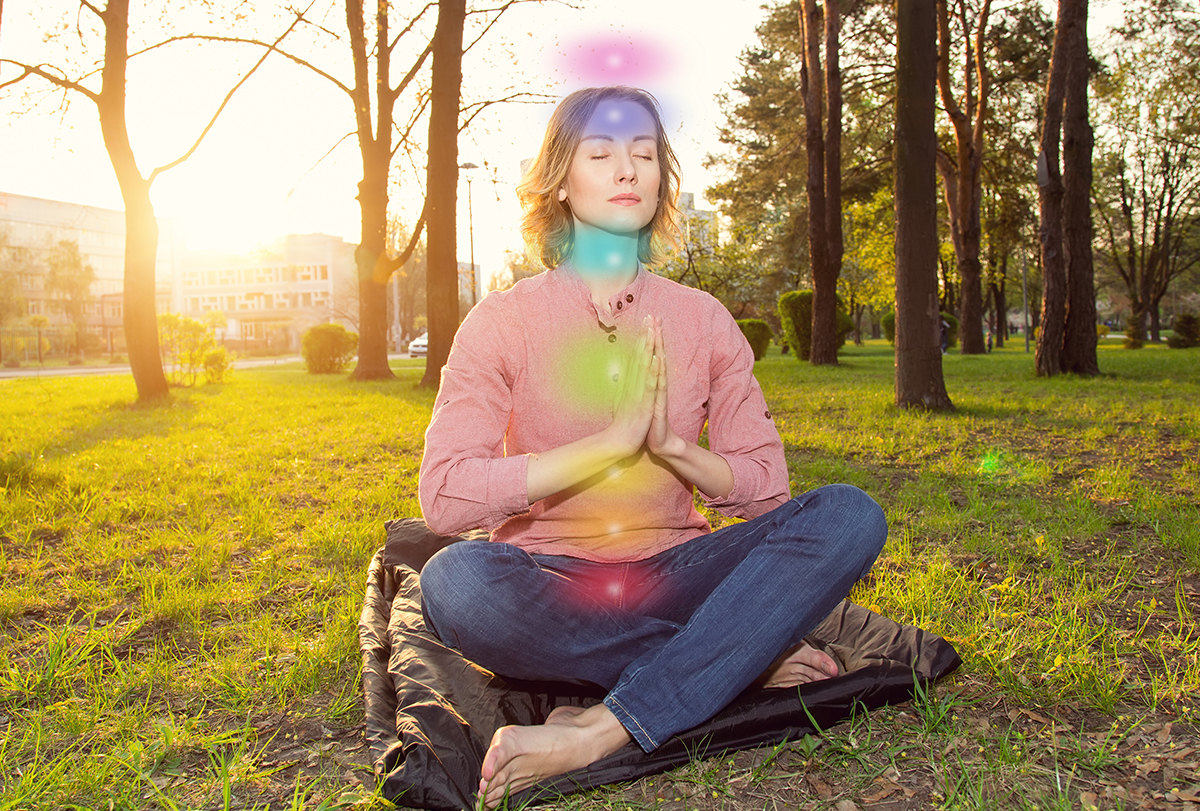
In Sanskrit, the word “chakra” translates to “disk” and is representative of the fact that chakras are like spinning disks of energy that circulate through the body.
What Science Says About the Chakras
There are seven main chakras and each one correlates to different parts of the body. Every chakra governs a different area of the endocrine and nervous systems. (1) In addition, the energetic channels of the body line up with the physical channels of the body, creating an equivalency between the two.
The chakras also match up with different sections of the vertebrae, affecting the corresponding parts of the body.
By studying the physical and metaphysical together, one can see the direct relationship between the two. The images of the chakras are often found in nature – in flowers, stars, and even magnified images of cells. (2)(3)
Each chakra is a circular aura that signifies its own individual type of life energy. These circular vortexes of life energy align themselves along the spinal column and are connected to different internal organs.
Yoga and meditation basically hinge on the opening and balancing of these seven chakras or auras. Even though the concept of life energy, forms the crux of ancient schools of medicine and has remained relevant to this day, it is largely theoretical in nature.
Science has neither proved nor disproved the existence of these auras, as they cannot be quantified in tangible terms.
The Seven Chakras and How to Open Them
Starting at the base of the spine and moving up to the crown of the head, the seven main chakras (in Sanskrit) are as follows:
- Muladhara chakra
- Svadhishthana chakra
- Manipura chakra
- Anahata chakra
- Vishuddha chakra
- Ajna chakra
- Sahasrara chakra
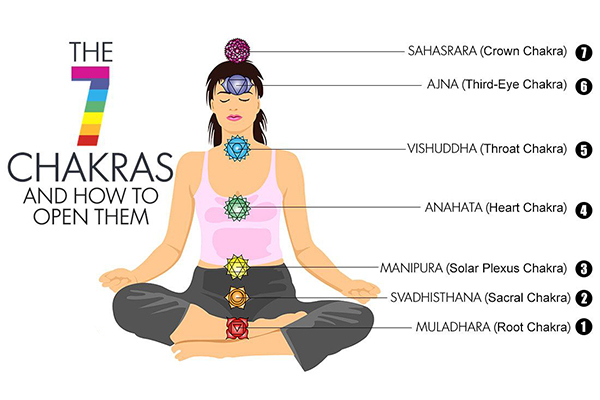
If any of these chakras become blocked, one’s energy cannot properly flow through the body. Therefore, when one learns to fully open the chakras, one can live a more fulfilled, healthy, and peaceful life. (4)
1. Muladhara Chakra (Root Chakra)
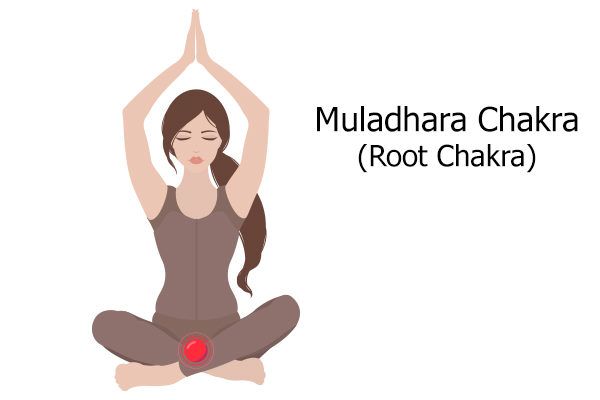
Location: Base of the spine
Color: Red
Mantra: LAM
Element: Earth
Represents: Safety, foundation, and groundedness
Blocked by: Belief that one is unsafe, abuse, neglect, financial troubles, childhood trauma, etc.
“Muladhara” translates to “foundation.” One might ask, “Am I safe? Is this world safe?”
Signs of a blocked Muladhara chakra include but are not limited to:
- Fear, panic
- Overthinking
- Depression, anxiety
- Bad dreams
- Emotional disconnect
- Anger
- Lack of trust
- Slothfulness
- Lack of confidence
Ways to open the Muladhara chakra include but are not limited to:
- Eating natural red foods
- Wearing the color red or placing this color around one’s house
- Meditating on the root chakra
- Grounding meditations
- Doing grounding yoga poses (such as the squat, child’s pose, and standing forward fold)
- Chanting “LAM”
- Walking barefoot to promote being grounded
- Connecting more with one’s family and facing one’s past as needed
2. Svadhishthana Chakra (Sacral Chakra)

Location: Two inches south of the navel
Color: Orange
Mantra: VAM
Element: Water
Represents: Passion, creativity, sexuality, fluidity, intimacy, trust, and procreation
Blocked by: Creative disconnect, judgment, conflict, guilt, and past sexual or relational trauma
The second chakra governs the relationships you share with others and how you put your creativity out into the world.
Signs of a blocked Svadhishthana chakra include but are not limited to:
- Creative blockages
- Guilt
- Toxicity in relationships
- Belief that one does not deserve love
- Belief that others do not care
- Block in motivation
- Lack of sexual desire
- Insecurity
- Lack of emotion
- Unhealthy sexual desires
- Need to control everything
- Addiction/dependency
- Bladder issues
- Kidney problems
Ways to open the Svadhishthana chakra include but are not limited to:
- Eating natural orange foods
- Wearing the color orange or placing this color around one’s house
- Meditating on the Sacral chakra
- Doing second chakra yoga poses (typically hip-opening poses)
- Chanting “VAM”
- Affirmations that one is deserving of love
- Practicing healthy sexuality/relationships
- Using one’s creativity as much as possible
3. Manipura Chakra (Solar Plexus Chakra)
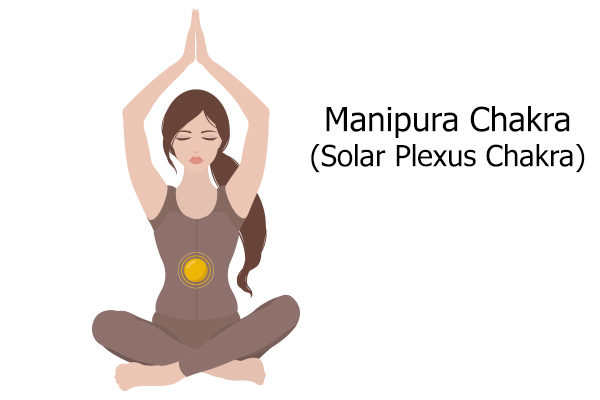
Location: Navel
Color: Yellow
Mantra: RAM
Element: Fire
Represents: Power, independence, and vitality
Blocked by: Eating the wrong foods, believing that one is weak, being bullied and/or victimized, lack of self-esteem, abuse, etc.
The Manipura chakra affects the digestive organs. When blocked, the digestive system may slow or speed up through the lack or abundance of one’s inner fire. This fire is also known as “tapas.”
Signs of a blocked Manipura chakra include but are not limited to:
- Anxiety
- Stomach pains
- Feeling powerless
- Feeling like a victim
- Lack of belief in oneself
- Relinquishing one’s power to others
- Liver, pancreas, and stomach problems
- Aggressiveness
- Egoism
Ways to open the Manipura chakra include but are not limited to:
- Eating natural yellow foods
- Wearing the color yellow or placing this color around one’s house
- Meditating on the Solar Plexus chakra
- Doing second chakra yoga poses (typically hip-opening poses)
- Chanting “RAM”
- Affirmations that one is enough
- Writing down what makes one special
- Doing yoga practices for this chakra by focusing on the inner fire or the belly (such as sun salutations, boat pose, bow pose, and cobra pose)
- Practicing bellows breath (Bhastrika Pranayama) or practicing the “breath of fire” (Kapalabhati Pranayama)
4. Anahata Chakra (Heart Chakra)
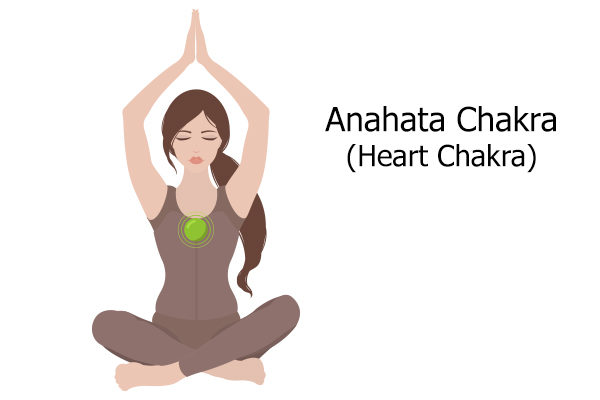
Location: Heart center
Color: Green
Mantra: YAM
Element: Air
Represents: Love, compassion, and affection
Blocked by: Stress, trauma, overthinking, lack of love, etc.
The Anahata chakra is the chakra of love and can easily be negatively affected by a lack of love. When one fully opens the heart chakra, one can let go of negative energies, allowing an unlimited source of love to draw from.
Signs of a blocked Anahata chakra include but are not limited to:
- Lack of compassion
- Unwillingness to let go of past relationships
- Holding onto grudges
- Lack of commitment
- Difficulty maintaining relationships
- Closing off the heart/not letting people in
- Lack of love for all
- Anxiety, stress
- Loneliness
Ways to open the Anahata chakra include but are not limited to:
- Eating natural green foods
- Wearing the color green or placing this color around one’s house
- Meditating on the heart chakra
- Doing heart chakra yoga poses (such as the fish pose, cat/cow, camel pose, and heart-melting pose)
- Chanting “YAM”
- Spending time in nature
- Affirmations of love for oneself and all living things
- Affirmations that one has an open heart
5. Vishuddha Chakra (Throat Chakra)
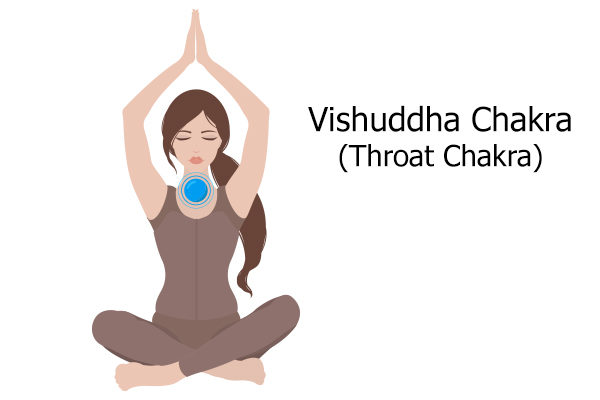
Location: Throat
Color: Blue
Mantra: HAM
Element: Ether (Space)
Represents: Voice, speaking, and hearing
Blocked by: Being told to stay quiet, being told that one’s voice does not matter or is not enough, trauma due to speaking up, etc.
If the Vishuddha chakra is used the wrong way, one might speak too much without letting others have the chance to be heard. One must find the balance of one’s voice.
Signs of a blocked Vishuddha chakra include but are not limited to:
- Sore throat/neck pain
- Hearing problems
- Temporomandibular (TMJ) syndrome
- Problems with the larynx and thyroid
- Feeling that one cannot speak up
- Unwillingness to use one’s voice or share one’s opinions
Ways to open the Vishuddha chakra include but are not limited to:
- Eating natural blue foods
- Wearing the color blue or placing this color around one’s house
- Meditating on the throat chakra
- Doing throat chakra yoga poses (such as the plow pose, shoulder stand, and fish pose)
- Chanting “HAM”
- Chanting mantras in general
- Practicing the lion’s breath (Simha Pranayama)
- Affirmations that one’s voice matters and that all voices matter
6. Ajna Chakra (Third-Eye Chakra)
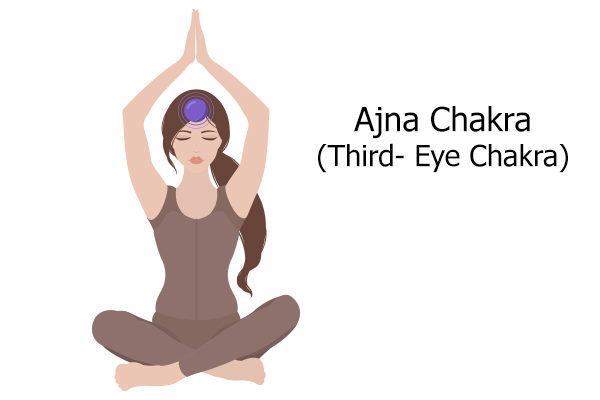
Location: Between the eyes
Color: Indigo
Mantra: OM/KSHAM
Element: Light
Represents: Seeing, intuition, wisdom, and understanding that there is more than just the visual sight
Blocked by: Lack of spiritual practice, restrained spiritual upbringing, illusion, etc.
When the Ajna chakra is open, one can begin to see and understand beyond the veil of illusion. This provides the opportunity to connect more spiritually and to be open to the metaphysical world.
Signs of a blocked Ajna chakra include but are not limited to:
- Lack of intuition
- Inability to concentrate
- Belief that what one sees physically is all that there is
- Disconnect of the mind, body, and soul
- Anxiety/fear of the unknown
- Lack of self-reflection
- Feeling that the thoughts are “cloudy”
- Inability to stay present
- Abundance of daydreaming
- Headaches
- Pain in the eyes, eye problems
- Sinus pain/problems
Ways to open the Ajna chakra include but are not limited to:
- Eating natural indigo foods
- Wearing the color indigo or placing this color around one’s house
- Meditating on the third-eye chakra and imagining this eye opening
- Meditating on a flame (such a small fire or a candle)
- Doing heart chakra yoga poses (such as the fish pose, cat/cow, camel pose, and heart-melting pose)
- Chanting “KSHAM” and/or “OM”
- Practicing alternate nostril breathing (Nadi Shodhana Pranayama)
- Spending time in nature
- Meditating more in general
7. Sahasrara Chakra (Crown Chakra)
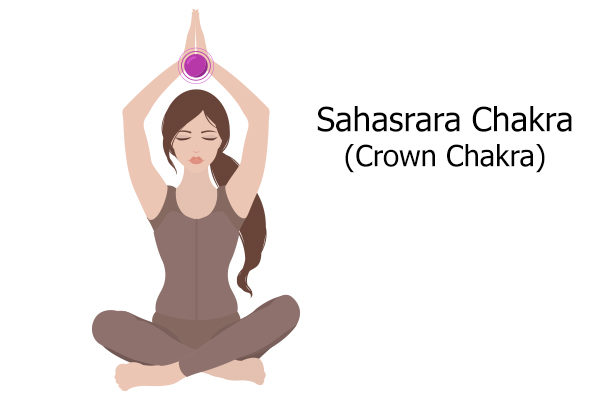
Location: Crown of the head
Color: White/violet
Mantra: OM
Element: Thought/all other elements
Represents: Mindfulness, spirituality, connection, and balance
Blocked by: Negative relationships, fear of change, ego, etc.
When the crown chakra is open, one is able to be fully connected to all life, one’s self, and one’s higher power.
Signs of a blocked Sahasrara chakra include but are not limited to:
- Lack of intuition
- Feeling unconnected
- Isolation
- Egoism
- Headaches
- Fear of death/dying
- Lack of balance/coordination
- Trouble with memory
Ways to open the Sahasrara chakra include but are not limited to:
- Eating natural white and violet foods
- Wearing the colors violet and/or white or placing these colors around one’s house
- Meditating on the crown chakra
- Meditating more in general
- Chanting “OM”
- Spending more time in nature
- Doing yoga poses for the crown chakra (such as the headstand and corpse pose)
- Affirmations that one is more than just the body
- Affirmations that energy lives forever
Additional Ways to Open the Chakras
Each chakra can also be opened through specific mudras, crystals, tones, etc. Everybody is unique, and each technique will affect every person a little bit differently. Therefore, one should be open to different ideas and willing to learn what works for oneself.
Final Word
The art of opening your chakras to restore proper energy balance in the body may not have much scientific support, but it is rooted in ancient wisdom. This form of meditative healing helps you find and address the deep-seated unresolved trauma, feelings, and memories that you carry around with you.
This emotional burden tends to have a negative bearing on the functioning of your mind and body and can manifest in the form of physical illnesses over time. Balancing your chakras is aimed at relieving you off this load and thereby improving your well-being at all levels.
- Was this article helpful?
- YES, THANKS!NOT REALLY


